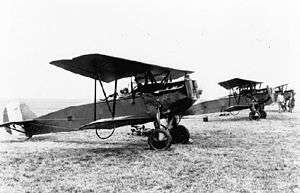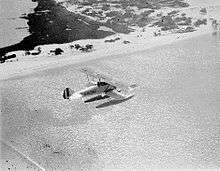Huff-Daland TW-5
The Huff-Daland Type XV Training Water-Cooled TW-5 was a biplane trainer designed by the Huff-Daland Aero Corporation in the early 1920s for the United States Army Air Service.
| TW-5 | |
|---|---|
 | |
| AT-1s | |
| Role | Trainer |
| Manufacturer | Huff-Daland |
| Primary users | United States Army Air Service United States Navy |
| Produced | 1923 |
| Number built | 26 |
Design and development
It was a development of the TA-6 (which itself was a one-off redesigned TA-2 with a 220 hp Lawrance J-1 air-cooled engine) but powered by a 190 hp Wright-Hispano E2. In 1924, the letter-and-number system was revised, and the TW-5 became an Advanced Trainer AT-1. In 1927, Huff-Daland Aero Corporation became a division of Keystone Aircraft Corporation.
Operational history
Versions of the AT-1 were built for the United States Navy as training and observation aircraft.
Variants

HN-1
The
- TA-6 (Trainer, Air-cooled type 6)
- Powered by the 200 hp Lawrance J-1 air-cooled engine, 1 built
- TW-5 (Trainer, Water-cooled type 5)
- Powered by the 150-hp (112-kW) Wright-Hispano I engine, 5 built.
- AT-1
- U.S. Army Advanced Trainer, 10 built.
- AT-2
- One aircraft tested in a number of single-seat and two-seat versions
- HN-1
- United States Navy version of the AT-1 powered by a 180hp Wright-Hispano E2 engine, 3 built.
- HN-2
- United States Navy version of the AT-1 powered by a 200hp Lawrance J-1, 3 built.
- HO-1
- United States Navy observation version of the HN-1 powered by a 180hp Wright-Hispano E2 engine with interchangeable wheel or float undercarriage, 3 built
Specifications (AT-1)
General characteristics
- Crew: 2
- Length: 24 ft 7 in (7.5 m)
- Wingspan: 31 ft 2 in (9.5 m)
- Gross weight: 2,358 lb (1,070 kg)
- Powerplant: 1 × Wright Hisso I V-8 water-cooled piston engine, 150 hp (110 kW)
Performance
- Maximum speed: 112 mph (180 km/h, 97 kn)
gollark: You can use factory upgrades/
gollark: Stick in maybe glowstone coolers between the moderator pairs.
gollark: Because speed upgrades are more compact.
gollark: 1mRF/t = 1 milliRF/t.
gollark: Well, in material cost, not power use.
References
| Wikimedia Commons has media related to Huff-Daland TW-5. |
- "United States Military Aircraft Since 1908" by Gordon Swanborough & Peter M. Bowers, 1977, 675 pp.
This article is issued from Wikipedia. The text is licensed under Creative Commons - Attribution - Sharealike. Additional terms may apply for the media files.